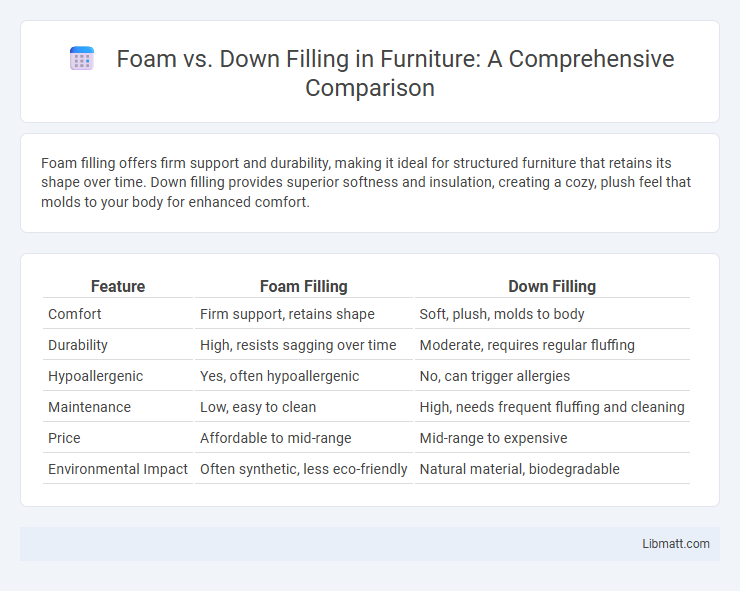Foam filling offers firm support and durability, making it ideal for structured furniture that retains its shape over time. Down filling provides superior softness and insulation, creating a cozy, plush feel that molds to your body for enhanced comfort.
Table of Comparison
| Feature | Foam Filling | Down Filling |
|---|---|---|
| Comfort | Firm support, retains shape | Soft, plush, molds to body |
| Durability | High, resists sagging over time | Moderate, requires regular fluffing |
| Hypoallergenic | Yes, often hypoallergenic | No, can trigger allergies |
| Maintenance | Low, easy to clean | High, needs frequent fluffing and cleaning |
| Price | Affordable to mid-range | Mid-range to expensive |
| Environmental Impact | Often synthetic, less eco-friendly | Natural material, biodegradable |
Introduction to Foam and Down Fillings
Foam filling consists of synthetic polyurethane or memory foam materials known for their consistent support, durability, and resistance to allergens and moisture, making them ideal for mattresses and cushions. Down filling, derived from the soft under feathers of ducks or geese, offers exceptional insulation, breathability, and lightweight comfort, favored in luxury bedding and outerwear. Understanding the differences in material properties helps you choose the right filling to suit your comfort preferences and specific needs.
Key Differences Between Foam and Down
Foam filling provides consistent support and durability with hypoallergenic properties, making it ideal for those sensitive to allergens, while down filling offers exceptional softness, warmth, and natural insulation but requires regular maintenance to prevent clumping. Foam retains its shape better over time, ensuring long-lasting comfort, whereas down tends to compress, needing frequent fluffing to maintain loft and performance. Your choice depends on whether you prioritize firm, allergy-friendly support or plush, lightweight warmth.
Comfort and Support Comparison
Foam filling provides consistent support by contouring to Your body shape, offering excellent pressure relief and durability, making it ideal for those seeking firm comfort. Down filling delivers a plush, luxurious feel with superior softness and breathability, but it may lack the structured support that foam offers. Choosing between foam and down depends on whether You prioritize firm support or a softer, more cushioned sleep experience.
Durability and Longevity
Foam filling offers superior durability due to its ability to retain shape and resist breakdown over time, making it ideal for high-use furniture and cushions. Down filling provides exceptional comfort and softness but tends to compress and lose loft more quickly, requiring regular fluffing and replacement to maintain support. Choosing foam ensures longer lifespan and consistent performance, while down prioritizes plushness with moderate longevity.
Insulation and Warmth Performance
Down filling offers superior insulation by trapping air within its clusters, providing excellent warmth-to-weight ratio ideal for cold weather. Foam filling, often made from synthetic fibers, delivers consistent insulation performance even when wet, but typically weighs more and provides less warmth compared to down. The choice between foam and down depends on specific needs for moisture resistance and thermal efficiency in various environments.
Allergen Considerations
Foam filling is hypoallergenic and resistant to dust mites, making it ideal for individuals with allergies or asthma. Down filling, derived from bird feathers, often triggers allergic reactions due to proteins and dust accumulation. Choosing foam over down minimizes exposure to allergens, enhancing indoor air quality and comfort.
Maintenance and Cleaning Requirements
Foam filling requires minimal maintenance and can be cleaned easily with spot treatment, making it ideal for users seeking low-effort upkeep. Down filling demands more care, including periodic fluffing to maintain loft and professional cleaning to prevent clumping and preserve insulation quality. Your choice depends on whether you prioritize convenience or natural material benefits when it comes to maintenance and cleaning.
Cost Analysis: Foam vs Down
Foam filling typically offers a more budget-friendly option compared to down, with prices significantly lower due to synthetic manufacturing processes. Down filling, sourced from waterfowl feathers, generally commands a higher cost reflecting its natural insulation properties and durability. Your decision hinges on balancing the upfront investment of down's premium quality against foam's cost-effective performance.
Environmental Impact
Foam filling often involves synthetic materials derived from petrochemicals, which can contribute to pollution during production and pose challenges in waste management due to their non-biodegradable nature. Down filling, sourced from natural bird feathers, is biodegradable and renewable but raises ethical concerns related to animal welfare and often involves resource-intensive farming practices. Choosing between foam and down filling for your products requires weighing environmental sustainability against ethical considerations and material longevity.
Choosing the Right Filling for Your Needs
Foam filling offers superior support and durability, ideal for individuals seeking firm cushioning and maintaining shape over time. Down filling provides exceptional softness and breathability, perfect for those who prioritize lightweight comfort and insulation. Selecting between foam and down depends on the desired balance of support, comfort, and maintenance preferences.
Foam vs down filling Infographic

 libmatt.com
libmatt.com